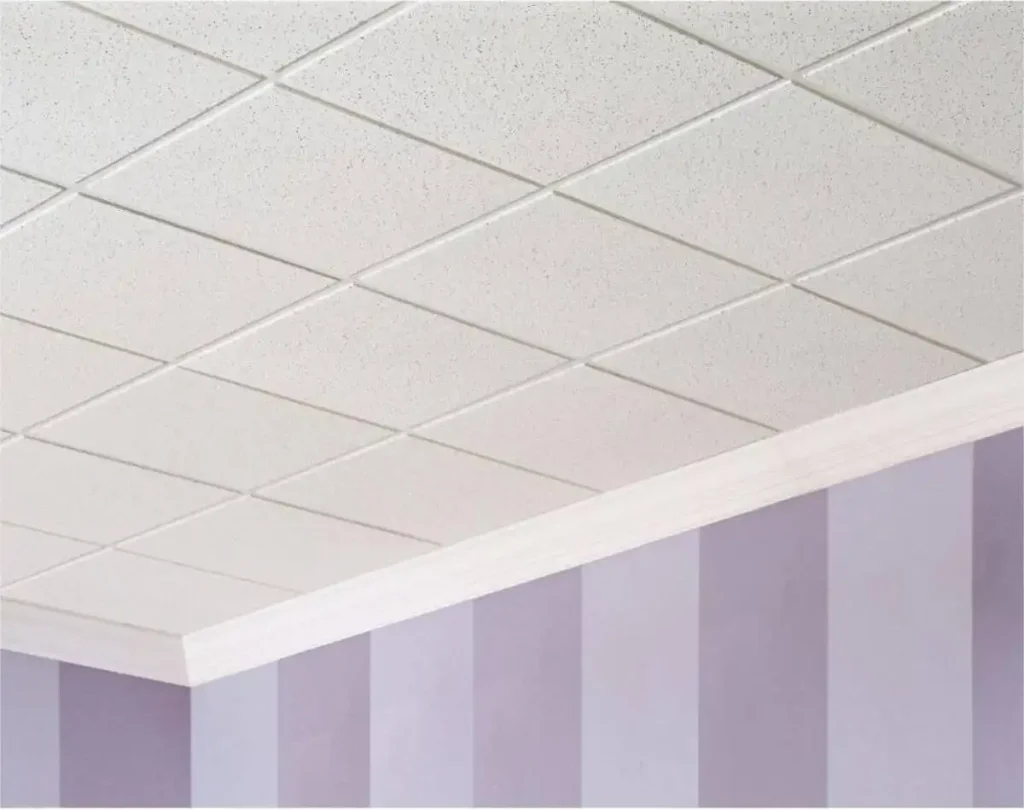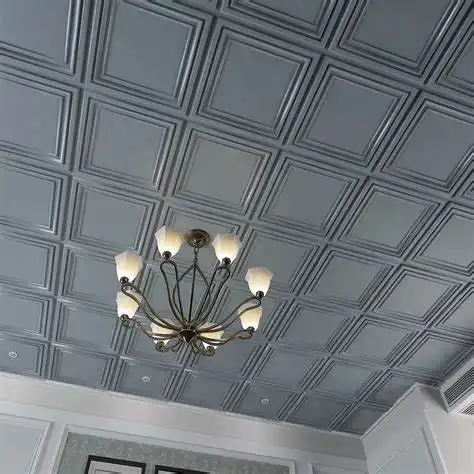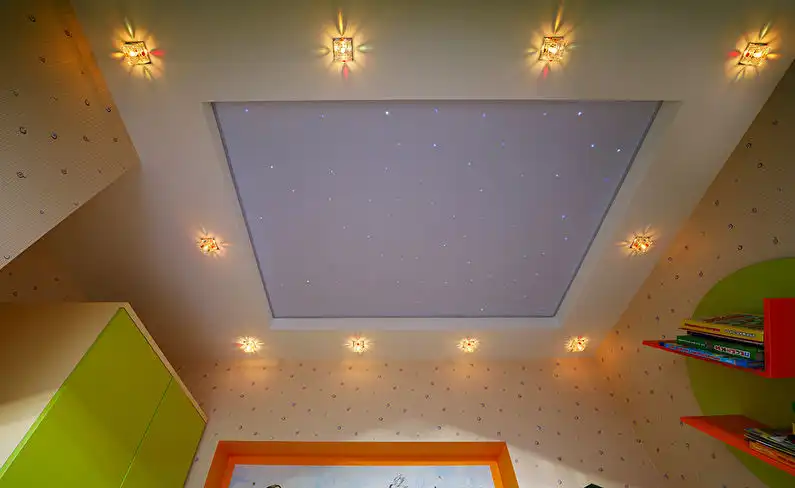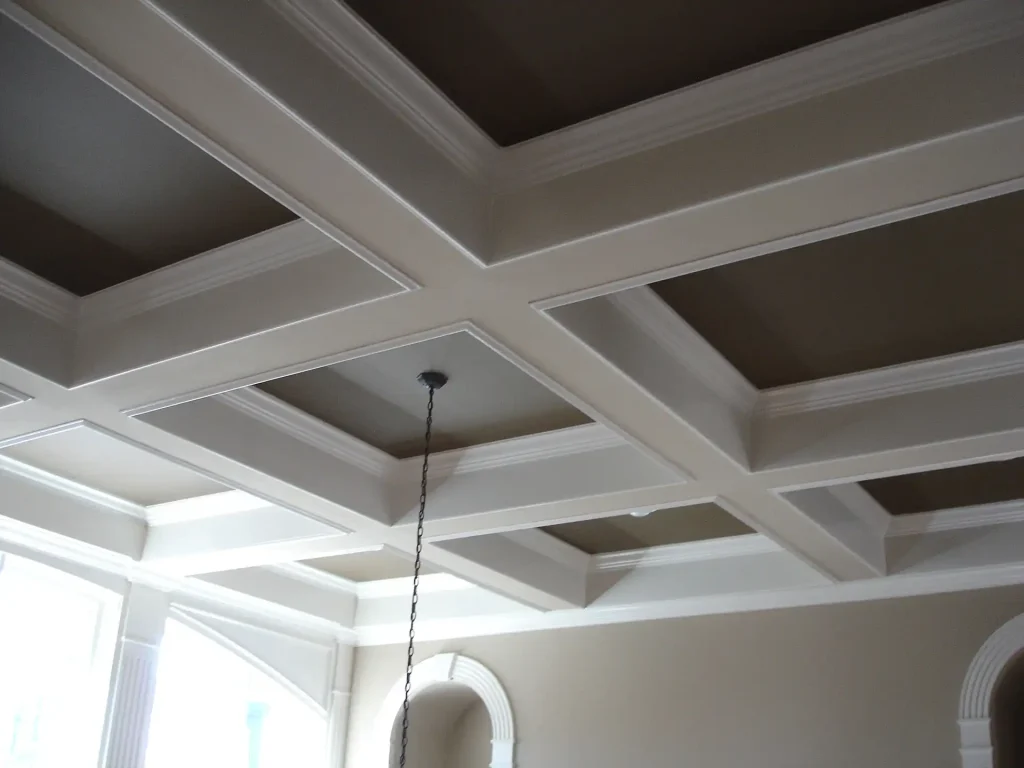The selection of ceiling materials is a crucial aspect of interior design. Ceilings not only provide a functional purpose by protecting the space above, but they also contribute to the overall aesthetic appeal of a room. When choosing ceiling materials, several factors should be taken into account, including the desired style, budget, maintenance requirements, and functional needs. It is essential to have a clear understanding of the advantages and disadvantages of each ceiling materials to make an informed decision. Let’s delve into the various types of ceiling materials and explore their unique characteristics.

Gypsum Board Ceiling Materials
メリット の Gypsum Board Ceiling Materials
- Versatility in design and finishes: Gypsum boards can be easily shaped, textured, or painted to achieve various aesthetic effects, making them suitable for different interior styles.
- Cost-effective option: Gypsum boards are relatively affordable compared to other ceiling materials, making them a popular choice for both residential and commercial projects.
- Easy installation and repair: Gypsum boards are lightweight and can be quickly installed or replaced, facilitating efficient construction or remodeling processes.
Disadvantages の Gypsum Board Ceiling Materials
- Susceptible to moisture damage: Gypsum boards can deform or get harm when exposed to high levels of humidity or water leaks
- Limited durability contrasted to other materials: Gypsum boards tend to cracking or sagging over time, specially in environments with important temperature fluctuations or structural movements.
- Tend to cracking and sagging over time: Gypsum boards more tend to affect damage than other materials, and they may need frequent fixes or maintenance. They also tend to splitting and drooping over time.

Acoustic Ceiling Tiles
メリット の Acoustic Ceiling Tiles
- Superior sound absorption properties: Acoustic ceiling tiles are designed to improve the acoustics of a room by reducing noise levels and minimizing sound reverberation.
- Enhances acoustics in a space: These tiles are particularly beneficial in areas where noise control is essential, such as offices, classrooms, or entertainment venues.
- Conceals wiring and ductwork: Acoustic ceiling tiles provide a practical solution for hiding electrical wiring, HVACシステム, and other utilities.
Disadvantages の Acoustic Ceiling Tiles
- Limited design options and aesthetic appeal: Acoustic ceiling tiles tend to have a standardized appearance, which may not suit all design preferences or architectural styles.
- Prone to staining and discoloration: Over time, acoustic ceiling tiles can become stained or discolored, particularly in areas with high humidity or exposure to smoke.
- Difficult to repair or replace damaged tiles: In the event of damage or deterioration, replacing or repairing acoustic ceiling tiles can be challenging and may require professional assistance.

Metal Ceiling Panels
メリット の Metal Ceiling Panels
- Modern and sleek aesthetic: Metal ceiling panels provides a contemporary appearance, adding A hint of delicacy to any space.
- Durable and long-lasting: Metal ceilings are highly durable, resistant to wear and tear, and can stand the test of time.
- Fire-resistant properties: Metal ceilings are non-flammable, offering an added layer of safety and compliance with fire regulations.
Disadvantages の Metal Ceiling Panels
- Higher cost compared to other materials: Metal ceiling panels can be more expensive than some other options, which may impact the overall project budget.
- Limited insulation properties: Metal ceilings have minimal insulation capabilities, meaning they may not contribute significantly to thermal or acoustic insulation.
- Susceptible to dents and scratches: While metal ceilings are generally durable, they can be susceptible to dents or scratches if subjected to significant impact or force.

Wood Ceiling Panels
メリット の Wood Ceiling Panels
- Natural and warm aesthetic: Wood ceiling panels give a room a feeling of coziness and natural beauty, making it feel warm and inviting.
- Wide selection of patterns and finishes: Wood provides a number of alternatives for patterns, stains, and finishes, enabling customisation and design freedom.
- Can be customized and shaped: It may be modified and carved to produce distinctive ceiling designs or architectural features. Wood is a versatile material.
Disadvantages の Wood Ceiling Panels
- Susceptible to warping and moisture damage: Wood ceilings are susceptible to moisture and humidity, which can cause rotting, warping, or the development of mold and mildew.
- Greater care needs: To keep their look and protect them from moisture, wood ceilings need regular maintenance such as sealing, staining, or painting.
- Susceptible to insect infestation: Wood ceilings are susceptible to insect infestation, specially if they are not properly maintained or treated.

PVC Ceiling Tiles
メリット の PVC Ceiling Tiles
- Moisture-resistant and suitable for humid environments: PVC ceiling tiles are highly resistant to moisture, making them ideal for areas with high humidity levels, such as bathrooms or kitchens.
- Easy to clean and maintain: PVC tiles are easy to clean and require minimal maintenance. They can be wiped down with a damp cloth or mild cleaning solution to remove dirt or stains.
- Cost-effective option: PVC ceiling tiles are generally more affordable than other materials, offering a budget-friendly alternative for those seeking a durable and practical ceiling solution.
Disadvantages の PVC Ceiling Tiles
- Limited design options and finishes: PVC ceiling tiles may have a more limited range of design options compared to other materials, which could restrict creative possibilities.
- Not as durable as other materials: While PVC tiles are relatively durable, they may be more prone to damage, such as cracking or breaking, compared to stronger materials like metal or gypsum.
- Susceptible to fading and discoloration over time: Prolonged exposure to sunlight or harsh environmental conditions can cause PVC ceiling tiles to fade or discolor, affecting their aesthetic appeal.

Fiber Cement Boards Ceiling Materials
メリット の Fiber Cement Boards Ceiling Materials
- Durable and moisture-resistant: Fiber cement boards are highly durable and resistant to moisture, making them suitable for areas prone to humidity or moisture exposure.
- Versatile in design and finishes: Fiber cement boards come in various textures and finishes, offering versatility in achieving different design aesthetics.
- Fire-resistant properties: Fiber cement boards have excellent fire-resistant properties, providing an added layer of safety to the space.
Disadvantages の Fiber Cement Boards Ceiling Materials
- Higher cost compared to other materials: Fiber cement boards may be more expensive than some other ceiling materials, impacting the overall project budget.
- Requires professional installation: Due to their weight and specific installation requirements, fiber cement boards often necessitate professional installation, adding to the overall project cost.
- Heavy and may require additional structural support: Fiber cement boards are relatively heavy, which may require additional structural support during installation, especially for larger ceiling areas.

Stretch Ceiling Materials
メリット の Stretch Ceiling Materials
- Seamless and modern appearance: Stretch ceilings offer a sleek, seamless look that can enhance the overall aesthetics of a space.
- Wide range of colors and lighting options: Stretch ceilings come in various colors and can include integrated lighting systems, allowing for creative design possibilities.
- Easy installation and maintenance: Stretch ceilings are relatively easy to install and require minimal maintenance, making them a convenient option for many projects.
Disadvantages の Stretch Ceiling Materials
- Higher cost compared to other materials: Stretch ceilings can be more expensive than traditional ceiling materials, which may impact the project budget.
- Limited design options for complex shapes: While stretch ceilings offer versatility, they may have limitations when it comes to creating complex shapes or architectural features.
- Requires professional installation: Due to the specialized installation techniques involved, stretch ceilings typically require professional installation, adding to the overall project cost.

Coffered Ceiling Materials
メリット の Coffered Ceiling Materials
- Adds architectural interest and elegance: Coffered ceilings create a sense of architectural grandeur and add a touch of elegance to any space.
- Customizable with various molding and beam options: Coffered ceilings can be customized with different molding profiles and beam arrangements, allowing for unique design expressions.
- Enhances the value of a space: Coffered ceilings are considered a luxurious feature that can increase the value and appeal of a property.
Disadvantages の Coffered Ceiling Materials
- Requires professional installation: The installation of coffered ceilings usually requires professional expertise, as it involves intricate carpentry work and precise measurements.
- Higher cost compared to standard ceilings: Coffered ceilings can be more expensive than standard ceilings due to the additional materials and labor involved.
- Limited design options for lower ceiling heights: Coffered ceilings may not be suitable for spaces with low ceiling heights, as they can make the room feel smaller and more confined.

Suspended Ceiling Materials
メリット の Suspended Ceiling Materials
- Conceals utilities and wiring: Suspended ceilings provide a practical solution for hiding electrical wiring, HVAC systems, and other utilities, creating a clean and organized appearance.
- Easy access for maintenance and repairs: Suspended ceilings offer easy access to the space above, facilitating maintenance or repairs without disrupting the entire ceiling.
- Cost-effective option: Suspended ceilings are generally more cost-effective compared to other ceiling materials, making them a popular choice for commercial spaces.
Disadvantages の Suspended Ceiling Materials
- Limited design options and aesthetic appeal: Some ceiling materials, such as acoustic ceiling tiles or PVC ceiling tiles, may have limited design options and may not offer the same level of aesthetic appeal as other materials like wood or metal ceiling panels.
- Lower ceiling height compared to other materials: Certain ceiling materials, such as suspended ceilings or coffered ceilings, can reduce the overall ceiling height of a room. This can be a disadvantage if you have a space with limited vertical clearance, as it may make the room feel smaller or more cramped.
- May require additional structural support: Some ceiling materials, like fiber cement boards or stretch ceilings, may require additional structural support due to their weight or installation requirements. This can add complexity and potentially increase the cost of the project.

Aluminum Ceiling Materials

Advantages of Aluminum Ceiling Materials
- 耐久性がある: Aluminum is a highly durable material that is resistant to corrosion, rust, and moisture damage. It can stand hard environmental situations and is suitable for both indoor and outdoor using.
- 軽量だ: Aluminum is a lightweight material, making it easier to carry and install contracted to heavier materials like wood or metal. This can help simplify the installation process and reduce labor and transportation costs.By the way, 1000 series aluminum alloy is a more suitable material for ceiling, it has a strong decorative, good weather resistance, fire, moisture, easy to install and easy to clean. The 1000 series aluminum alloys include 1050 aluminum alloy, 1060 aluminum alloy, 1070 aluminum alloy, 1100 aluminum alloy, and orange pear aluminum sheet. In addition to 1000 series aluminum alloys, 6000 series aluminum alloys are more common and are used in industry, aerospace and construction. 6000 series aluminum alloys include 6005 aluminum alloys, 6061 aluminum alloys, 6063 aluminum alloys, and 6068 aluminum alloys.
- Versatility: Aluminum ceilings provide many kinds of design choices and finishes, allowing for multipurpose in creating different styles and aesthetics. They can be customized with many kinds of patterns, textures, and colors to suit different design preferences.
- Low Maintenance: Aluminum ceilings need minimal maintenance. They are easy to clean, as the surface can be wiped clean with a damp cloth. What’s more, aluminum does not need painting or sealing to keep its appearance and durability.
- 耐火性: Aluminum is a non-combustible material, making it highly resistant to fire. This can improve safety in buildings and comply with fire regulations.

Disadvantages of Aluminum Ceiling Materials
- Cost: Aluminum ceilings can be more expensive compared to other ceiling materials such as gypsum board or PVC tiles. The cost of aluminum and its installation may be higher, which can impact the overall project budget.
- Limited Insulation: Aluminum is not an effective insulating material and has low thermal insulation properties. As a result, it may not contribute significantly to energy efficiency or soundproofing in a space. Additional insulation materials may be required to achieve desired insulation levels.
- Noise Reflection: Aluminum ceilings can reflect sound rather than absorb it, which may result in an echoing or reverberating effect in a room. This can be a disadvantage in spaces where acoustic performance is important, such as auditoriums or concert halls.
- Vulnerability to Dents and Scratches: While aluminum is durable, it can be susceptible to dents and scratches, particularly in high-traffic areas or environments where there is a risk of impact or accidental damage.

In conclusion, selecting the right ceiling material is crucial for achieving both functional and aesthetic goals in interior design. It is essential to carefully consider the advantages and disadvantages of each material to make an informed decision that aligns with your specific needs and preferences.
Recapping the key points for each ceiling materials
- Gypsum Board: Versatile, cost-effective, and easy to install, but susceptible to moisture damage and may require frequent repairs.
- Acoustic Ceiling Tiles: Excellent sound absorption properties and utility concealment, but limited design options and difficult to repair or replace.
- Metal Ceiling Panels: Modern and durable with fire-resistant properties, but higher cost, limited insulation, and susceptible to dents and scratches.
- Wood Ceiling Panels: Natural and warm aesthetic with customization options, but prone to moisture damage, higher maintenance, and insect infestation.
- PVC Ceiling Tiles: Moisture-resistant and easy to clean, cost-effective, but limited design options, less durable, and susceptible to fading over time.
- Fiber Cement Boards: Durable, versatile in design, and fire-resistant, but higher cost, requires professional installation, and may need additional structural support.
- Stretch Ceilings: Seamless and modern appearance, wide color and lighting options, easy installation and maintenance, but higher cost, limited design options for complex shapes, and requires professional installation.
- Coffered Ceilings: Adds architectural interest and elegance, customizable with various molding and beam options, but requires professional installation, higher cost, and limited design options for lower ceiling heights.
- Suspended Ceilings: Conceals utilities and wiring, easy access for maintenance and repairs, cost-effective, but limited design options, lower ceiling height, and may require additional structural support.
- Aluminum ceilings: Possess durability, lightweight construction, versatility in design options, low maintenance, and fire resistance, while disadvantages include higher cost, limited insulation properties, potential for noise reflection, and vulnerability to dents and scratches.

It is crucial to evaluate your specific needs, budget, style preferences, and maintenance requirements before selecting a ceiling material. By considering these factors and understanding the advantages and disadvantages of each option, you can make an informed decision that will enhance the beauty and functionality of your space.


